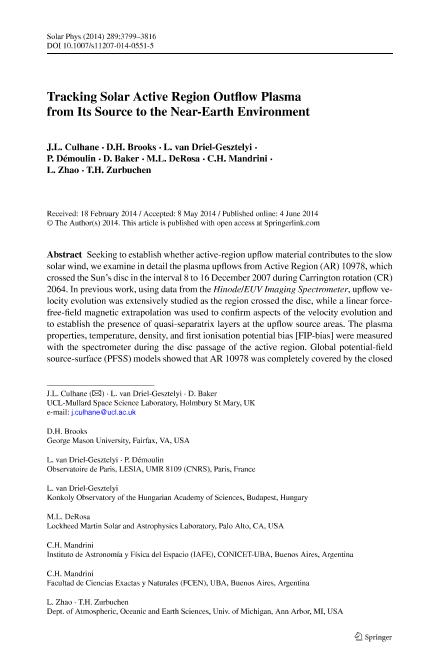Artículo
Tracking Solar Active Region Outflow Plasma from Its Source to the Near-Earth Environment
Culhane, J. l.; Brooks, D. H.; van Driel Gesztelyi, Lidia; Démoulin, Pascal; Baker, D.; DeRosa, M.l.; Mandrini, Cristina Hemilse ; Zhao, L.; Zurbuchen, T. H.
; Zhao, L.; Zurbuchen, T. H.
 ; Zhao, L.; Zurbuchen, T. H.
; Zhao, L.; Zurbuchen, T. H.
Fecha de publicación:
10/2014
Editorial:
Springer
Revista:
Solar Physics
ISSN:
0038-0938
Idioma:
Inglés
Tipo de recurso:
Artículo publicado
Clasificación temática:
Resumen
Seeking to establish whether active region upflow material contributes to the slow solar wind, we examine in detail the plasma upflows from Active Region (AR)10978, which crossed the Sun's disc in the interval 8 to 16 December, 2007 during Carrington rotation (CR)2064. In previous work, using data from the Hinode/EUV Imaging Spectrometer, upflow velocity evolution was extensively studied as the region crossed the disc while a linear force-free magnetic extrapolation was used to confirm aspects of the velocity evolution and to establish the presence of quasi-separatrix layers at the upflow source areas. The plasma properties, temperature, density and first ionisation potential bias (FIP-bias) were measured with the spectrometer during the disc passage of the active region. Global potential field source surface (PFSS) models showed that AR 10978 was completely covered by the closed field of a helmet streamer that is part of the streamer belt. Thus it is not clear how any of the upflowing AR-associated plasma could reach the source surface at 2.5 R(Sun)and contribute to the slow solar wind. However a detailed examination of solar-wind in-situ data obtained by the Advanced Composition Explorer (ACE) spacecraft at the L1 point shows that the increase in O^7+/O^6+, C^6+/C^5+ and Fe/O - a FIP-bias proxy - are present before the heliospheric current sheet crossing. These increases, along with an accompanying reduction in proton velocity and an increase in density are characteristic of both AR and slow-wind plasma. Finally we describe a two-step reconnection process by which some of the upflowing plasma from the AR could reach the heliosphere.
Palabras clave:
Active Region Upflows
,
Magnetic Topology
,
Slow Solar Wind
Archivos asociados
Licencia
Identificadores
Colecciones
Articulos(IAFE)
Articulos de INST.DE ASTRONOMIA Y FISICA DEL ESPACIO(I)
Articulos de INST.DE ASTRONOMIA Y FISICA DEL ESPACIO(I)
Citación
Culhane, J. l.; Brooks, D. H.; van Driel Gesztelyi, Lidia; Démoulin, Pascal; Baker, D.; et al.; Tracking Solar Active Region Outflow Plasma from Its Source to the Near-Earth Environment; Springer; Solar Physics; 289; 10; 10-2014; 3799-3816
Compartir
Altmétricas



